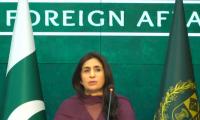It’s not every day that you see history in the making. Watching the leaders of North and South Korea, locked in an existential struggle for more than six decades, take those deliberate steps towards peace with great dignity last week was a surreal experience even for distant observers like me.
And no, North Korea’s Kim Jong-un is not a trigger-happy maniac with two horns on his head, out to blow up the world, as he has often been portrayed by the Western media. After years of vilification, lampooning and being portrayed as a dangerous, madcap of a dictator – just as his father and grandfather and many in the Middle East have been portrayed over the years – it was refreshing to note that he is human and normal after all.
By walking across the forbidding line that has divided the two countries and their people for nearly seven decades, and embracing his South Korean counterpart, Kim has not just made history; he seems to have stolen Trump’s thunder ahead of the much-anticipated summit with the American leader. Hence those peevish portents from the ‘tweeter-in-chief,’ soon after patting himself on the back for making the North Korean leader fall in line, that “America will not be played!”
But Trump or no Trump, the two Koreas seem to have already moved on. And in the end, it’s not the US bluff and bluster but years of patient diplomacy and sincere efforts for reconciliation by the South that seem to have worked in persuading Pyongyang that it’s time for a fresh start. Trump’s unpredictable, volatile nature and his crude talk of raining death and destruction on the North may have of course added weight and urgency to those efforts.
Clearly, there is an overwhelming constituency for peace and change on both sides of the divide. The two Koreas have been living cheek by jowl and on the brink of a potential catastrophe since the North went nuclear largely in response to American threats, not to mention the presence of thousands of US forces in South Korea since the Korean war.
In the case of a conflagration between the North and South, or between the US and Pyongyang, it’s not just the Korean Peninsula but the whole of Asia Pacific that will likely blow up. The stakes for the region have never been higher.
While the North has remained stuck in a time warp, following the Stalinist one party – and one family – tyranny, South Korea has emerged as an amazing Asian success story in no time. The demanding culture of excellence that it encourages has been a source of envy to many in the West and around the world.
Battling acute poverty, a crumbling infrastructure and all-round decay, the North has missed out on this revolution. A young leader like Kim Jong-un, born long years after the Korean war ended, has an historic opportunity to open his country to change and do it on its own terms, rather than wait to be swept off its feet by forced change.
While it is too early to predict the outcome of the proposed Trump-Kim summit, normalisation of ties between the two Koreas, on the one hand, and between Pyongyang and Washington, on the other, are bound to help all sides. The potential dividends of peace are infinite. Look at the spectacular example of Germany and how it has transformed itself after the reunification. A Korean reunification could transform the region itself.
Yet there are many, including the powerful global players, who would want the status quo to prevail. It will take real courage and leadership on the part of the Korean twins to surmount these challenges.
Predictably, the Korean thaw has well-meaning pundits wondering if a similar rapprochement between India and Pakistan is possible. Indeed, as I watched the Koreans go through those elaborately choreographed rites of passage for peace, with the rest of the stunned global audience, that was the first thought that occurred to me.
What prevents India and Pakistan from shedding their 70 years of baggage and take that leap of faith for peace and a more rewarding future for their people? Much like the two Koreas, the South Asian twins have had an incredibly volatile and difficult past, not to mention the three wars that they have fought over Kashmir.
Yet they share robust historical and emotional bonds in every sphere – from religion and culture to economics, and from literature and cinema to the arts – which have endured despite the politics of opportunism and resistance from the powerful on both sides.
Isn’t it about time the South Asians moved on too? What will it take for India and Pakistan to embrace peace and restore normal relations between their people who have so much in common and not long ago were one?
As Atal Behari Vajpayee, the BJP’s first prime minister, liked to argue with respect to Pakistan, you can change history but you cannot change geography. You cannot choose your neighbours; you have to live with those you have inherited and make the best of the relationship.
In the words of Talat Masood, a former lieutenant general of the Pakistan Army, “If after about six and a half decades of intense hostility the two Koreas are willing to talk. And the American president who until recently was threatening to wipe North Korea out of existence would be engaging in dialogue with impulsive Kim, why not the Indians and [the] Pakistanis?”
Why not, indeed?
More than India, it is Pakistan that stands to lose from the deleterious effects of this long-festering relationship with its big eastern neighbour. Even as Pakistan remained preoccupied with its largely India-centric defence and security paradigm, India had been sowing the seeds of an economic revolution under Dr Manmohan Singh in his earlier avatar.
Thanks largely to that economic liberalisation – and party because of long years of sustained peace and democratic governance – India has been witnessing an unprecedented boom today, helping it emerge as the world’s fastest growing economy.
Even Bangladesh, Pakistan’s former other half, has been economically transformed thanks to its hard-working people and relative peace and stability. Pakistan has unfortunately been left out of this economic makeover of South Asia, thanks to long years of misguided priorities and policies and perpetual political instability.
Both authoritarian and civilian governments have repeatedly let down Pakistan and its people. Of course, corruption in high places is hardly a phenomenon peculiar to Pakistan. Only the extent of it in the country is phenomenal.
I am not suggesting that peace and normalisation of relations with India would put an end to corruption in Pakistani politics. However, it would certainly help Pakistan get out of a breakneck arms race and focus instead on building its political and economic institutions and empowerment of its people.
Just imagine the immense economic potential of trade, tourism and cultural exchange if India and Pakistan opened their borders and stopped treating each other’s people as terrorists. A South Asian thaw has the potential to transform the whole region, from Karachi to Kolkata and beyond. The future is incredibly tantalising and within striking distance. We just need leaders who have the vision to see beyond their noses. Another world is possible.
The writer is an independent writer and former newspaper editor.
Email: aijaz.syed@hotmail.com
A woman walks past a building of the International Monetary Fund. — AFP/FileThe annual and spring meetings of the...
Late Benazir Bhutto's daughter Asifa Bhutto Zardari addresses the Christian community in Bihar Colony on January 23,...
Representational image. — PexelsWater is an important scarce natural resource that is required for several everyday...
Pakistani employees of online marketplace company Kaymu at work in Karachi. — AFP/FileThe true spirit of development...
India uses Afghanistan as a backstage area to carry out terrorist attacks against Pakistan
Another report by the Pakistan Institute of Peace Studies states that 78 per cent of attacks have been carried out by...







